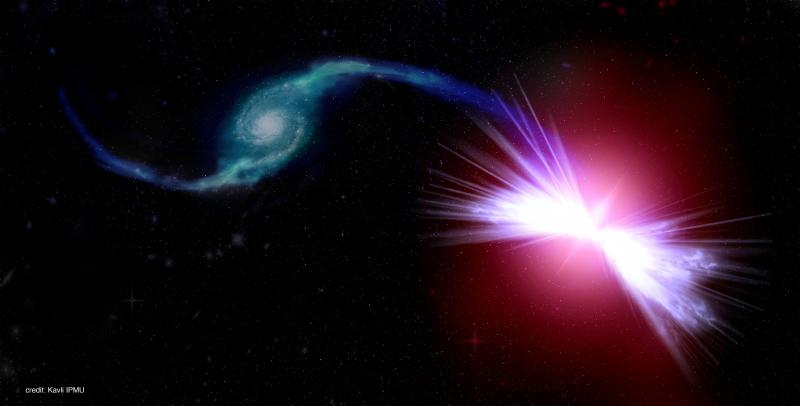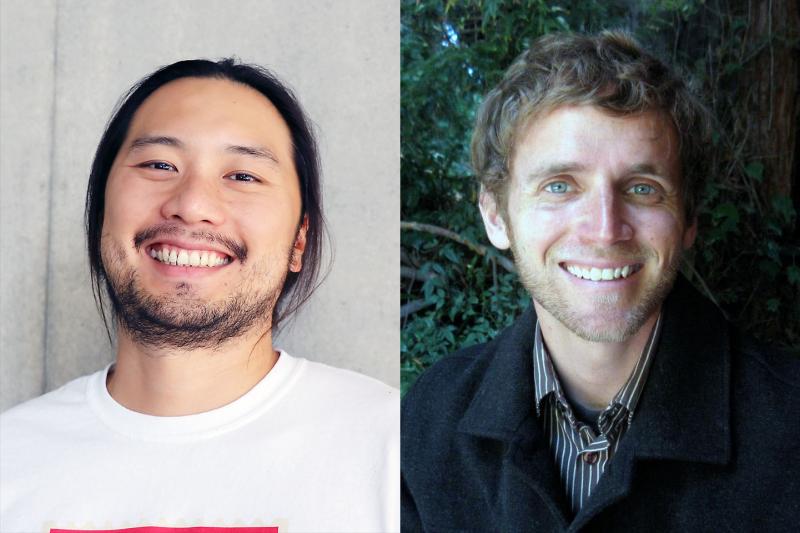May 26, 2016
Kavli Institute for the Physics and Mathematics of the Universe (Kavli IPMU)

Scientists have uncovered a new class of galaxies with supermassive black hole winds that are energetic enough to suppress future star formation.
Devoid of fresh young stars, red and dead galaxies make up a large fraction of galaxies in our nearby universe, but a mystery that has plagued astronomers for years has been how these systems remain inactive despite having all of the ingredients needed to form stars. Now, an international team of researchers have used optical imaging spectroscopy from the Sloan Digital Sky Survey-IV Mapping Nearby Galaxies at Apache Point Observatory (SDSS-IV MaNGA) to catch a supermassive black hole in the act of heating gas within its host galaxy, leading to the prevention of star formation.
“Stars are created by the cooling and collapse of gas, but in these galaxies there are no new stars despite an abundance of gas. It’s like we have rain clouds hanging over a desert, but none of the rainwater is reaching the ground,” said Edmond Cheung, Project Researcher at the Kavli Institute for the Physics and Mathematics of the Universe (Kavli IPMU), and lead author of a new study published in Nature on May 26.

The team studied a galaxy nicknamed Akira, the prototypical example of the newly discovered class of galaxies called "red geysers” - red referring to the color of galaxies that lack young blue stars, and geyser referring to the episodic wind outbursts from the supermassive black hole. Akira showed intriguing and complex patterns of warm gas, implying the presence of an outflowing wind from the supermassive black hole in its center. The researchers say the fuel for Akira’s supermassive black hole likely came from the interaction with a smaller galaxy, nicknamed Tetsuo. The outflowing wind had enough energy to heat the surrounding gas through shocks and turbulence and could ultimately prevent any future star formation.
These are some of the early results from the Kavli IPMU-led SDSS-IV MaNGA survey, which began observations in 2014. The technology involved in the new survey allows scientists to map galaxies ten to one hundred times faster than before, making it possible to build large enough samples required to catch galaxies undergoing rapidly changing phenomena.
“The critical power of MaNGA is the ability to observe thousands of galaxies in three dimensions, by mapping not only how they appear on the sky, but also how their stars and gas move inside them,” said Kevin Bundy, MaNGA’s Principal Investigator and Kavli IPMU Project Assistant Professor.
The team will continue to analyze the survey’s data and plans a number of follow-up studies to further reveal the role of red geysers on the evolution of galaxies.
Paper details
Journal: Nature
Title: Suppressing star formation in quiescent galaxies with supermassive black hole winds
Authors: Edmond Cheung (1), Kevin Bundy (1), Michele Cappellari (2), Sébastien Peirani (1,3), Wiphu Rujopakarn (1,4), Kyle Westfall (5), Renbin Yan (6), Matthew Bershady (7), Jenny E. Greene (8), Timothy M. Heckman (9), Niv Drory (10), David R. Law (11), Karen L. Masters (4), Daniel Thomas (4), David A. Wake (7,12), AnneMarie Weijmans (13), Kate Rubin (14), Francesco Belfiore (15,16), Benedetta Vulcani (1), Yan-mei Chen (17), Kai Zhang (6), Joseph D. Gelfand (18,19), Dmitry Bizyaev (20,21), A. Roman-Lopes (22), Donald P. Schneider (23,24)
Author affiliations:
1. Kavli Institute for the Physics and Mathematics of the Universe (WPI), The University of Tokyo Institutes for Advanced Study, The University of Tokyo, Kashiwa, Chiba 2778583, Japan
2. Subdepartment of Astrophysics, Department of Physics, University of Oxford, Denys Wilkinson Building, Keble Road, Oxford OX1 3RH, UK
3. Institut d’Astrophysique de Paris (UMR 7095: CNRS and UPMC), 98 bis Bd Arago F75014 Paris, France
4. Department of Physics, Faculty of Science, Chulalongkorn University, 254 Phayathai Road, Pathumwan, Bangkok 10330, Thailand
5. Institute for Cosmology and Gravitation, University of Portsmouth, Dennis Sciama Building, Burnaby Road, Portsmouth PO1 3FX
6. Department of Physics and Astronomy, University of Kentucky, 505 Rose Street, Lexington, KY 405060055, USA
7. Department of Astronomy, University of WisconsinMadison, 475 North Charter Street, Madison, WI 53706, USA
8. Department of Astrophysical Sciences, Princeton University, Princeton, NJ 08544, USA
9. Center for Astrophysical Sciences, Department of Physics & Astronomy, The Johns Hopkins University, Baltimore, Maryland 21218
10. McDonald Observatory, Department of Astronomy, University of Texas at Austin, 1 University Station, Austin, TX 787120259, USA
11. Space Telescope Science Institute, 3700 San Martin Drive, Baltimore, MD 21218, USA
12. Department of Physical Sciences, The Open University, Milton Keynes, MK7 6AA, UK
13. School of Physics and Astronomy, University of St Andrews, North Haugh, St Andrews, Fife KY16 9SS, UK
14. HarvardSmithsonian Center for Astrophysics, 60 Garden Street, Cambridge, MA 02138, USA
15. Cavendish Laboratory, University of Cambridge, 19 J.J. Thomson Ave, CB3 0HE Cambridge, UK
16. University of Cambridge, Kavli Institute for Cosmology, CB3 0HE Cambridge, UK
17. Department of Astronomy, Nanjing University, Nanjing 210093, China
18. NYU Abu Dhabi, P.O. Box 129188, Abu Dhabi, UAE
19. Center for Cosmology and Particle Physics, New York University, Meyer Hall of Physics, 4 Washington Place, New York, NY 10003, USA
20. Apache Point Observatory and New Mexico State University, P.O. Box 59, Sunspot, NM, 883490059, USA
21.Sternberg Astronomical Institute, Moscow State University, Moscow
22. Departamento de Física y Astronomía, Facultad de Ciencias, Universidad de La Serena, Cisternas 1200, La Serena, Chile
23. Department of Astronomy and Astrophysics, The Pennsylvania State University, University Park, PA 16802
24. Institute for Gravitation and the Cosmos, The Pennsylvania State University, University Park, PA 16802
DOI: 10.1038/nature18006 (Published May 26, 2016)
Paper abstract (Nature): http://nature.com/articles/doi:10.1038/nature18006
Media contact:
Motoko Kakubayashi
Press Officer
Kavli Institute for the Physics and Mathematics of the Universe
The University of Tokyo Institutes for Advanced Study,
The University of Tokyo
TEL: +81-04-7136-5980
E-mail: press_at_ipmu.jp
*change _at_ to @
Research contact:
Edmond Cheung
Project Researcher
Kavli Institute for the Physics and Mathematics of the Universe
The University of Tokyo Institutes for Advanced Study,
The University of Tokyo
TEL: +81-04-7136-6553
E-mail: edmond.cheung_at_ipmu.jp
*change _at_ to @
Kevin Bundy
Project Assistant Professor
Kavli Institute for the Physics and Mathematics of the Universe
The University of Tokyo Institutes for Advanced Study,
The University of Tokyo
TEL: +81-04-7136-6513
E-mail: kevin.bundy _at_ ipmu.jp
*change _at_ to @
Useful links
All images can be downloaded from this page: http://web.ipmu.jp/press/201605-Akira/






